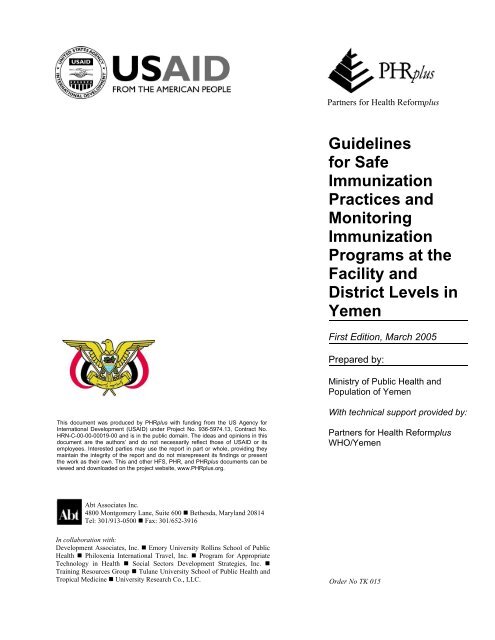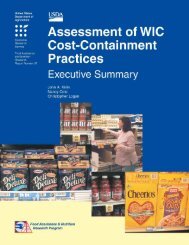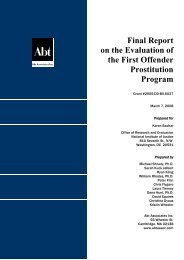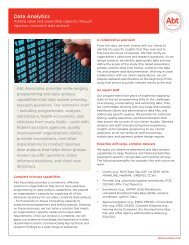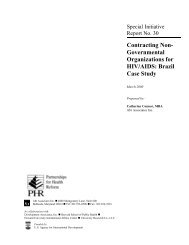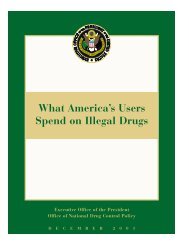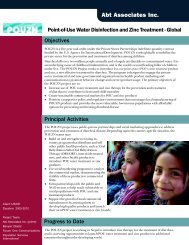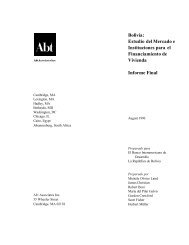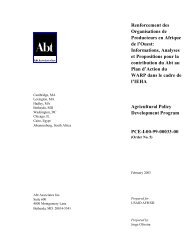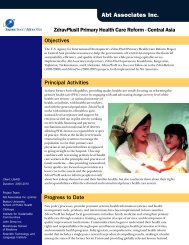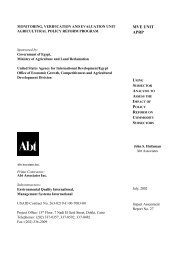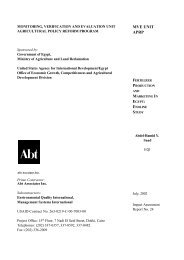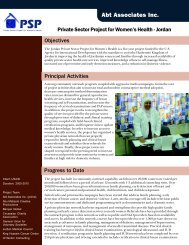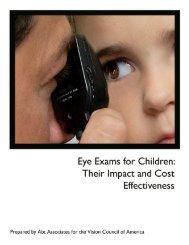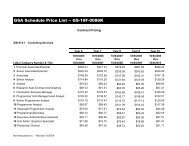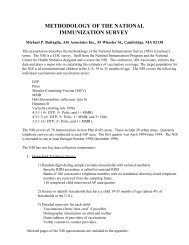Guidelines for safe immunization practices and ... - Abt Associates
Guidelines for safe immunization practices and ... - Abt Associates
Guidelines for safe immunization practices and ... - Abt Associates
Create successful ePaper yourself
Turn your PDF publications into a flip-book with our unique Google optimized e-Paper software.
Partners <strong>for</strong> Health Re<strong>for</strong>mplus<br />
<strong>Guidelines</strong><br />
<strong>for</strong> Safe<br />
Immunization<br />
Practices <strong>and</strong><br />
Monitoring<br />
Immunization<br />
Programs at the<br />
Facility <strong>and</strong><br />
District Levels in<br />
Yemen<br />
First Edition, March 2005<br />
Prepared by:<br />
Ministry of Public Health <strong>and</strong><br />
Population of Yemen<br />
This document was produced by PHRplus with funding from the US Agency <strong>for</strong><br />
International Development (USAID) under Project No. 936-5974.13, Contract No.<br />
HRN-C-00-00-00019-00 <strong>and</strong> is in the public domain. The ideas <strong>and</strong> opinions in this<br />
document are the authors’ <strong>and</strong> do not necessarily reflect those of USAID or its<br />
employees. Interested parties may use the report in part or whole, providing they<br />
maintain the integrity of the report <strong>and</strong> do not misrepresent its findings or present<br />
the work as their own. This <strong>and</strong> other HFS, PHR, <strong>and</strong> PHRplus documents can be<br />
viewed <strong>and</strong> downloaded on the project website, www.PHRplus.org.<br />
With technical support provided by:<br />
Partners <strong>for</strong> Health Re<strong>for</strong>mplus<br />
WHO/Yemen<br />
<strong>Abt</strong> <strong>Associates</strong> Inc.<br />
4800 Montgomery Lane, Suite 600 • Bethesda, Maryl<strong>and</strong> 20814<br />
Tel: 301/913-0500 • Fax: 301/652-3916<br />
In collaboration with:<br />
Development <strong>Associates</strong>, Inc. • Emory University Rollins School of Public<br />
Health • Philoxenia International Travel, Inc. • Program <strong>for</strong> Appropriate<br />
Technology in Health • Social Sectors Development Strategies, Inc. •<br />
Training Resources Group • Tulane University School of Public Health <strong>and</strong><br />
Tropical Medicine • University Research Co., LLC.<br />
Order No TK 015
Mission<br />
Partners <strong>for</strong> Health Re<strong>for</strong>mplus is USAID’s flagship project <strong>for</strong> health policy <strong>and</strong> health system<br />
strengthening in developing <strong>and</strong> transitional countries. The five-year project (2000-2005) builds on<br />
the predecessor Partnerships <strong>for</strong> Health Re<strong>for</strong>m Project, continuing PHR’s focus on health policy,<br />
financing, <strong>and</strong> organization, with new emphasis on community participation, infectious disease<br />
surveillance, <strong>and</strong> in<strong>for</strong>mation systems that support the management <strong>and</strong> delivery of appropriate<br />
health services. PHRplus will focus on the following results:<br />
<br />
<br />
<br />
<br />
<br />
Implementation of appropriate health system re<strong>for</strong>m.<br />
Generation of new financing <strong>for</strong> health care, as well as more effective use of existing funds.<br />
Design <strong>and</strong> implementation of health in<strong>for</strong>mation systems <strong>for</strong> disease surveillance.<br />
Delivery of quality services by health workers.<br />
Availability <strong>and</strong> appropriate use of health commodities.<br />
March 2005<br />
Recommended Citation<br />
Ministry of Public Health <strong>and</strong> Population of Yemen. March 2005. <strong>Guidelines</strong> <strong>for</strong> Safe Immunization Practices <strong>and</strong> Monitoring Immunization Programs at<br />
the Facility <strong>and</strong> District Levels in Yemen. First Edition. Bethesda, MD: The Partners <strong>for</strong> Health Re<strong>for</strong>mplus Project, <strong>Abt</strong> <strong>Associates</strong> Inc.<br />
For additional copies of this report, contact the PHRplus Resource Center at PHR-InfoCenter@abtassoc.com or visit<br />
our website at www.PHRplus.org.<br />
Contract/Project No.:<br />
Submitted to:<br />
<strong>and</strong>:<br />
HRN-C-00-00-00019-00<br />
USAID/Sana’a<br />
Karen Cavanaugh, CTO<br />
Health Systems Division<br />
Office of Health, Infectious Disease <strong>and</strong> Nutrition<br />
Center <strong>for</strong> Population, Health <strong>and</strong> Nutrition<br />
Bureau <strong>for</strong> Global Programs, Field Support <strong>and</strong> Research<br />
United States Agency <strong>for</strong> International Development
Abstract<br />
This is the first edition of <strong>Guidelines</strong> <strong>for</strong> Safe Immunization Practices <strong>and</strong> Monitoring<br />
Immunization Programs at the Facility <strong>and</strong> District Levels in Yemen. It is a compendium of revised<br />
EPI (Exp<strong>and</strong>ed Programme on Immunization) documentation; recordkeeping <strong>and</strong> reporting<br />
requirements of the Ministry of Public Health <strong>and</strong> Population; current guidelines <strong>for</strong> <strong>immunization</strong><br />
data analysis <strong>and</strong> utilization; <strong>and</strong> materials <strong>for</strong> monitoring <strong>and</strong> evaluating the <strong>immunization</strong> system<br />
<strong>and</strong> provider per<strong>for</strong>mance. The guidelines will be piloted in Amran Governorate in 2005;<br />
recommendations based on pilot experience will be incorporated into revised guidelines <strong>for</strong> use<br />
nationwide.<br />
The manual is designed primarily <strong>for</strong> health personnel who are responsible <strong>for</strong> the<br />
implementation of the <strong>immunization</strong> program at the facility <strong>and</strong> district levels. The section on<br />
evaluation of the work at facilities can guide both the facilities in doing self-evaluations <strong>and</strong> district<br />
<strong>immunization</strong> managers in monitoring <strong>and</strong> supervising facility-level work.<br />
The worksheets contained in this manual <strong>for</strong> monitoring <strong>immunization</strong> work are illustrative. A<br />
full set of worksheets has been published separately in an <strong>immunization</strong> workbook <strong>for</strong> districts.
Table of Contents<br />
Acronyms ..............................................................................................................................................ix<br />
Contributors...........................................................................................................................................xi<br />
Acknowledgments ...............................................................................................................................xiii<br />
1. Immunization Schedule ..................................................................................................................1<br />
2. Contraindications to Immunization ................................................................................................3<br />
3. Immunization Safety.......................................................................................................................5<br />
3.1 Safe Injection Practices .........................................................................................................5<br />
3.2 Safe Disposal of Injection Equipment...................................................................................6<br />
3.3 Selecting Safe <strong>and</strong> Effective Vaccines ..................................................................................6<br />
3.4 Reconstituting Vaccines Safely.............................................................................................7<br />
4. Adverse Events Following Immunization ......................................................................................9<br />
5. Record keeping <strong>and</strong> Reporting Documentation at the Facility Level...........................................11<br />
5.1 Defining a Facility’s Catchment Area.................................................................................11<br />
5.2 Determining Target Populations <strong>for</strong> Immunization.............................................................13<br />
5.3 Registration of Routine Immunizations...............................................................................18<br />
5.4 Registration of Immunizations during Mass Campaigns such as National Immunization<br />
Days.....................................................................................................................................18<br />
5.5 Routine Monthly Reporting about Immunization Work .....................................................19<br />
5.6 Reordering Vaccines <strong>and</strong>/or Immunization-related Materials.............................................21<br />
5.7 Cold Chain Maintenance (<strong>safe</strong> vaccine storage) .................................................................21<br />
5.8 Monitoring of Immunization Per<strong>for</strong>mance at the Facility...................................................24<br />
6. Recordkeeping, Reporting <strong>and</strong> Monitoring at the District Level .................................................27<br />
6.1 Monthly Report on Immunization Practice .........................................................................27<br />
6.2 Worksheet on Immunization Coverage of Children Under 1 Year by Antigen ..................30<br />
6.3 Worksheet on Vaccines <strong>and</strong> Materials Usage in District ....................................................32<br />
6.4 Worksheet <strong>for</strong> the Analysis of Barriers to Immunization in the District.............................35<br />
6.5 Vaccine <strong>and</strong> Supply Monitoring Register ...........................................................................37<br />
6.6 Cold Chain Equipment Inventory Book ..............................................................................39<br />
6.7 Evaluating Work at Immunization Points ...........................................................................41<br />
7. In<strong>for</strong>mation-based Response Matrix.............................................................................................43<br />
Table of Contents<br />
vii
List of Tables<br />
Table 1. Schedule <strong>for</strong> Childhood Routine Immunizations, Yemen, 2005 ....................................................1<br />
Table 2. Schedule <strong>for</strong> Tetanus Toxoid Immunization...................................................................................2<br />
Table 3. Conditions that are NOT Contraindications <strong>for</strong> Vaccination..........................................................3<br />
Table 4. Adverse Events Following Immunization to be Reported Using Form I-1 ....................................9<br />
Table 5. Responses to Refrigeration Problems ...........................................................................................22<br />
Table 6. Acceptable Wastage Coefficients <strong>and</strong> Recommended Frequency of Immunization Sessions ....32<br />
List of Figures<br />
Figure 1. Planning Strategy <strong>for</strong> Immunization Service Delivery in a Catchment Area..............................12<br />
viii<br />
Table of Contents
Acronyms<br />
AD<br />
AFP<br />
BCG<br />
DG<br />
DPT<br />
EPI<br />
GIS<br />
HepB<br />
Hib<br />
HIS<br />
HIV/AIDS<br />
IV<br />
MoPH&P<br />
OPV<br />
Penta-3<br />
PHRplus<br />
TT(2+)<br />
UNICEF<br />
USAID<br />
VVM<br />
WCBA<br />
WHO<br />
Auto-disable/auto-destruct (syringes)<br />
Acute Flaccid Paralysis<br />
Bacille Calmette-Guerin Vaccine<br />
Director General<br />
Diptheria, Pertussis <strong>and</strong> Tetanus Vaccine<br />
Exp<strong>and</strong>ed Programme on Immunization<br />
Geographic In<strong>for</strong>mation Systems<br />
Hepatitis B Vaccine<br />
Hemophilus influenza Type B Vaccine<br />
Health In<strong>for</strong>mation Systems<br />
Human Immunodeficiency Virus/ Acquired Immunodeficiency Syndrome<br />
Intravenous<br />
Ministry of Public Health <strong>and</strong> Population<br />
Oral Poliovirus Vaccine<br />
Third Dose of Pentavalent Vaccine<br />
Partners <strong>for</strong> Health Re<strong>for</strong>mplus Project<br />
Tetanus Toxoid (at least two doses)<br />
United Nations Children’s Fund<br />
United States Agency <strong>for</strong> International Development<br />
Vaccine Vial Monitors<br />
Women of Childbearing Age<br />
World Health Organization<br />
Acronyms<br />
ix
Contributors<br />
This manual has been prepared by the Ministry of Public Health <strong>and</strong> Population (MoPH&P)<br />
exp<strong>and</strong>ed working group headed by Dr. Gamal Abdual-Sattar, General Manager <strong>for</strong> the Exp<strong>and</strong>ed<br />
Program on Immunization (EPI), <strong>and</strong> co-chaired by Dr. Mohammed Ibrahim, PHRplus Project<br />
Coordinator <strong>and</strong> the Coordinator of the Neonatal Tetanus Elimination in Yemen, with technical<br />
assistance from USAID/PHRplus.<br />
Contributors also included the following:<br />
Dr. Majid Al-Jonaid<br />
Dr. Ali Al-Mudhwahi<br />
Dr. Abdul-Hakeem Al-Kohlani<br />
Dr. Gamal Thabet Nasher<br />
Dr. Mohammed Hajar<br />
Mr. Areef Youssef<br />
Dr. Lamia Mobarek<br />
Dr. Abdul Jabbar Al-Ghaithi<br />
Dr. Nagib Abdulaziz Abdullah<br />
Mr. Ahmed Al-Sharji<br />
Mr. Abdulhakim Al-Nahari<br />
Mr. Mohammed Al Yossefi<br />
Mr. Abdulla Mothaher<br />
Mr. Mohammed Al-Ansi<br />
Dr. Osama Mere<br />
Dr. Abdulahalim Ayyash<br />
Dr. Abdulghani Alghozi<br />
Mr. Hadi AlAmdi<br />
Mr. Abdualem Ali<br />
Dr. Abdullatif Al-Wada’e<br />
Mr. Mohammed Ali<br />
Mr. Mohammed Hadi Al-Rahabi<br />
Mr. Abdulmalik Saleh Hussein<br />
Mr. Mohammed Al Koribi<br />
Dr. Mai Al-Moaid<br />
Deputy of Public Health Care Sector, MoPH&P<br />
Director General (DG) <strong>for</strong> Family Health, MoPH&P<br />
DG <strong>for</strong> Disease Surveillance, MoPH&P<br />
DG Health Policies Unit, MoPH&P<br />
GAVI Coordinator <strong>and</strong> EPI Consultant, MoPH&P<br />
EPI Manager, Aden Branch, MoPH&P<br />
Head, Population Sector, MoPH&P<br />
Deputy Head of Statistical Department, MoPH&P<br />
Meningitis Surveillance Coordinator<br />
Central EPI Supervisor<br />
PHC & EPI Manager, Dhamar Governorate<br />
EPI Manager, Marib Governorate<br />
EPI Manager, S’adah Governorate<br />
EPI Manager, Sana’a Governorate<br />
EPI Technical Advisor, WHO-Yemen<br />
Health officer, UNICEF-Yemen<br />
DG, Amran Governorate<br />
EPI Manager, Amran Governorate<br />
Assistant Amran Governorate EPI Manager<br />
AFP Surveillance Coordinator<br />
Amran District EPI Supervisor<br />
Khamer District EPI Supervisor<br />
Ayyal Soreeh District Supervisor<br />
Thula District EPI Supervisor<br />
Deputy Director, CATALYST<br />
Contributors<br />
xi
Acknowledgments<br />
The Ministry of Public Health <strong>and</strong> Population (MoPH&P) of Yemen <strong>and</strong> the Expert Group are<br />
grateful to the U.S. Agency <strong>for</strong> International Development (USAID)/Yemen <strong>for</strong> the opportunity to<br />
realize plans on elaboration <strong>and</strong> introduction of the new in<strong>for</strong>mation system as well as to Drs. Anton<br />
Luchitsky <strong>and</strong> Kathy Banke of PHRplus <strong>for</strong> their support <strong>and</strong> technical assistance with this process.<br />
The MoPH&P would like to also express its thanks to World Health Organization/Yemen,<br />
UNICEF/Yemen, <strong>and</strong> CATALYST/Yemen <strong>for</strong> their support in the implementation of the new<br />
in<strong>for</strong>mation system<br />
The production of this manual was funded by USAID under the prime contract No. HCN-C-00-<br />
00-00019-00.<br />
The <strong>immunization</strong> records shown in <strong>for</strong>ms in this publication do not<br />
refer to real persons <strong>and</strong> are used <strong>for</strong> illustrative purposes only.<br />
Acknowledgments<br />
xiii
1. Immunization Schedule<br />
The current (2005) childhood routine <strong>immunization</strong> schedule in Yemen is outlined in Table 1.<br />
Table 1. Schedule <strong>for</strong> Childhood Routine Immunizations, Yemen, 2005<br />
Age<br />
BCG<br />
Antigens Birth 6wk 10wk 14wk 9 mo 18mo<br />
X<br />
OPV X X X X<br />
DPT/HepB/Hib (Pentavalent) X X X<br />
Measles + Vitamin A X X<br />
The recommended course of each vaccine should be completed as scheduled. Giving doses too<br />
close together (less than the specified interval between doses) should be avoided, <strong>and</strong> any doses given<br />
at less than the recommended interval should not be counted as part of the primary series.<br />
Children may present <strong>for</strong> <strong>immunization</strong> later than the exact intervals <strong>and</strong> times specified. In this<br />
case, the child should be given the missed doses immediately, regardless of how large the gap<br />
between doses is.<br />
Example: A child was given the first doses of Pentavalent <strong>and</strong> oral poliovirus vaccine (OPV) 6-<br />
12 months ago. At the next health facility visit, this child should be given the second doses of<br />
Pentavalent <strong>and</strong> OPV, as well as any other vaccine(s) <strong>for</strong> which s/he is due or overdue. The series<br />
should then be continued according to the schedule, observing the minimum time interval between<br />
doses.<br />
Every attempt must be made to immunize children on time (as per the national Exp<strong>and</strong>ed<br />
Programme on Immunization [EPI] schedule). Any delay in completing the schedule exposes that child<br />
<strong>and</strong> all others in the community who are not fully immunized to precisely those risks of mortality <strong>and</strong><br />
morbidity from the target diseases that <strong>immunization</strong> is designed to avoid. There<strong>for</strong>e the statement<br />
above about what to do in the case of an interrupted series should NOT be interpreted as an excuse to<br />
delay the subsequent doses.<br />
Tetanus toxoid (TT) is given to women of childbearing age (WCBA) (15–45 years) according<br />
to the schedule in Table 2. There is no maximum interval between TT doses. However, minimum<br />
intervals between doses should be adhered to.<br />
1. Immunization Schedule 1
Table 2. Schedule <strong>for</strong> Tetanus Toxoid Immunization<br />
Dose number<br />
TT1<br />
TT2<br />
TT3<br />
TT4<br />
TT5<br />
Timing<br />
At first contact<br />
4 Weeks After TT1<br />
6 Months After TT2<br />
One Year After TT3<br />
One Year After TT4<br />
Example: A woman who got the first TT dose one year ago presents at the health facility. She<br />
should be given the second dose, but the series should not be restarted.<br />
Pregnant women may receive TT <strong>immunization</strong> at any time during the pregnancy,<br />
even in the first trimester.<br />
It is important that every opportunity is used to immunize not only children but also women of<br />
childbearing age. For instance, when a woman brings a child <strong>for</strong> an <strong>immunization</strong> visit, the health<br />
worker should determine the woman’s <strong>immunization</strong> status <strong>and</strong> offer TT vaccination if necessary.<br />
2 <strong>Guidelines</strong> <strong>for</strong> Safe Immunization <strong>and</strong> Monitoring of Immunization in Yemen
2. Contraindications to Immunization<br />
A contraindication to <strong>immunization</strong> is a condition that greatly increases the chances of a serious<br />
adverse reaction in a vaccine recipient. That is, if a vaccine is given to a person with a<br />
contraindication to the vaccine, then a resulting adverse reaction that harms the vaccine recipient<br />
could occur. There<strong>for</strong>e, vaccines should not be administered when a contraindication is present.<br />
However, it is important to note that there are very few absolute contraindications to EPI vaccines.<br />
False contraindications are a major cause of non-<strong>immunization</strong> or delays in completing the routine<br />
<strong>immunization</strong> schedule. If persons are not immunized due to illnesses that are not true<br />
contraindications, then an opportunity <strong>for</strong> <strong>immunization</strong> is lost.<br />
Two permanent contraindications to vaccination are:<br />
<br />
<br />
Severe allergy to a vaccine component or severe allergic reaction following a prior dose of a<br />
vaccine (e.g., anaphylaxis, collapse/shock, non-febrile convulsions)<br />
Encephalopathy within 7 days of pertussis vaccination<br />
Two temporary contraindications to BCG <strong>and</strong> measles vaccines are:<br />
<br />
<br />
Pregnancy (note: pregnant women may receive TT)<br />
Immunosuppression (due to immunodeficiency diseases, malignancies, or chemotherapy).<br />
However, OPV <strong>and</strong> measles vaccines should be given to people with HIV/AIDS.<br />
Table 3. Conditions that are NOT Contraindications <strong>for</strong> Vaccination<br />
<br />
<br />
<br />
<br />
<br />
<br />
<br />
<br />
<br />
<br />
<br />
Minor illnesses such as upper respiratory infections or diarrhea, with fever less than 38.5°C<br />
Allergy, asthma, or other atopic manifestations, hay fever, or "sniffles"<br />
Premature, small-<strong>for</strong>-date infants<br />
Malnutrition<br />
Child being breastfed<br />
Family history of convulsions<br />
Treatment with antibiotics, low-dose corticosteroids, or locally acting (e.g., topical or inhaled) steroids<br />
Dermatoses, eczema, or localized skin infection<br />
Chronic diseases of the heart, lung, kidney, <strong>and</strong> liver<br />
Stable neurological conditions, such as cerebral palsy <strong>and</strong> Down's syndrome<br />
History of jaundice after birth<br />
2. Contraindications to <strong>immunization</strong> 3
3. Immunization Safety<br />
3.1 Safe Injection Practices<br />
The World Health Organization (WHO) defines a <strong>safe</strong> injection as one that:<br />
<br />
<br />
<br />
Does no harm to the patient<br />
Does not expose the health worker to avoidable risk<br />
Does not result in waste that puts other people at risk<br />
Health workers should follow the following procedures when h<strong>and</strong>ling syringes <strong>and</strong> needles:<br />
<br />
<br />
<br />
<br />
<br />
<br />
<br />
<br />
<br />
<br />
<br />
Use a new needle <strong>and</strong> syringe <strong>for</strong> every injection.<br />
Do not use the syringe (or needle) if packaging is open or damaged.<br />
Attach the needle be<strong>for</strong>e removing the needle cap. Do not attempt to recap the needle<br />
be<strong>for</strong>e or after injection.<br />
Do not touch the needle or the rubber cap (septum) of the vaccine vial. If you touch any<br />
of these areas accidentally, discard the contaminated syringe <strong>and</strong> needle <strong>and</strong> open a new<br />
one(s).<br />
If auto-disable (AD) syringes are used, do not pull the piston until you are ready to fill the<br />
syringe with vaccine. Once you pull the piston out, the syringe is disabled; you will not<br />
be able to replace the piston <strong>and</strong> then pull it out again.<br />
Stick the needle into the vaccine vial rubber cap.<br />
Gently pull the piston to fill the syringe slightly past the 0.5 ml mark.<br />
Gently push the piston to remove excess air if necessary. Stop when you reach the 0.5 ml<br />
mark. If air remains in the syringe, discard the syringe <strong>and</strong> try again. If you expel too much<br />
air <strong>and</strong> no longer have 0.5 ml of vaccine in the syringe, discard the syringe. You should not<br />
vaccinate children with less than the full dose.<br />
Remove the syringe from the vaccine vial. Do not recap the needle.<br />
Inject the dose of vaccine. Do not use your finger to guide the needle into the injection<br />
site.<br />
If the injection site is bleeding, do not place your finger directly on the injection site to<br />
stop the bleeding; use a cotton swab.<br />
3. Immunization Safety 5
3.2 Safe Disposal of Injection Equipment<br />
1. Place syringes <strong>and</strong> needles in puncture-proof cardboard or<br />
plastic containers (<strong>safe</strong>ty boxes) immediately after use. Do not<br />
recap syringes be<strong>for</strong>e disposal. Do not use your h<strong>and</strong>s to<br />
remove the needle from the syringe. Do not use your h<strong>and</strong>s to<br />
bend or cut the needle after the injection.<br />
2. Fill the <strong>safe</strong>ty box until it is about ¾ full (or up to the “Full”<br />
line if there is one printed on the box). Do not <strong>for</strong>ce too many<br />
syringes into the box.<br />
3. Once the <strong>safe</strong>ty box is filled, close the lid <strong>and</strong> seal the box to<br />
avoid syringes spilling.<br />
4. Safety boxes should be filled only once, then destroyed<br />
immediately or put into a <strong>safe</strong> storage area <strong>and</strong> destroyed<br />
as soon as possible. This prevents needlestick injuries <strong>and</strong><br />
exposure to blood <strong>and</strong> body fluids, which could occur if<br />
dumping or reusing containers.<br />
What goes in the <strong>safe</strong>ty box?<br />
Disposable syringes, needles,<br />
needles from IV bags, lancets,<br />
other contaminated sharps<br />
Not <strong>for</strong> the <strong>safe</strong>ty box:<br />
Empty vials, cotton pads, gloves,<br />
other plastic materials<br />
5. When the box is full, dispose of it by burning. The<br />
compound in which incineration takes place must be<br />
secure. Auto-combustion incinerators achieving temperatures above 8000C are preferred,<br />
although burning can also be per<strong>for</strong>med in other types of incinerators, <strong>for</strong> instance, in a pit,<br />
drum, or constructed hearth. Open burning is not recommended because it can scatter waste. If<br />
<strong>safe</strong>ty boxes are placed in an open pit, the pit should not be so deep that people have to crawl<br />
down into the pit to start the fire. Do not bury <strong>safe</strong>ty boxes. If contaminated syringes somehow<br />
escape from the box <strong>and</strong> are carried into streams or fields, people may step on them or children<br />
may play with them, or water supplies may be contaminated.<br />
3.3 Selecting Safe <strong>and</strong> Effective Vaccines<br />
<br />
<br />
<br />
Check the expiry dates on the vaccine <strong>and</strong> diluent vials. Discard the vial if the expiry date<br />
has passed.<br />
If the label has come off, discard the vial.<br />
Discard the vial if contamination is suspected, that is, if:<br />
there are leaks or cracks in the vial<br />
there is a change in appearance or floating particles<br />
the opened vial has been submerged in water<br />
the top of the vial has been pierced by a used needle, or a sterile needle on a used<br />
syringe<br />
freeze-dried vaccine has been open <strong>for</strong> more than 6 hours after reconstitution<br />
a vial of liquid vaccine has been opened <strong>for</strong> more than 4 weeks<br />
6 <strong>Guidelines</strong> <strong>for</strong> Safe Immunization <strong>and</strong> Monitoring of Immunization in Yemen
Do not combine partially opened vials of vaccine:<br />
<br />
<br />
Assess if cold-sensitive vaccines (TT, liquid pentavalent)<br />
have been frozen by using the refrigerator log or the<br />
“shake test” (see picture). Discard the vials of frozen<br />
vaccine.<br />
Read the vaccine vial monitors (VVMs) to check that the<br />
vaccine has not been exposed to an excessive amount of<br />
heat. VVMs show the cumulative irreversible heat<br />
exposure to which a vial has been exposed.<br />
Discard the vial whose inner square is the same<br />
color or darker than the outside circle<br />
Vials with VVMs where the inner square has begun<br />
to darken (but is still lighter than the outside circle)<br />
should be used be<strong>for</strong>e the vials with a lighter inner<br />
square<br />
3.4 Reconstituting Vaccines Safely<br />
<br />
<br />
<br />
<br />
<br />
<br />
<br />
Use only diluent recommended by the manufacturer to reconstitute vaccine.<br />
Reconstituted vaccines should be kept between 2 0 <strong>and</strong> 8 0 C, <strong>and</strong> away from sunlight, to<br />
maintain their potency.<br />
Discard reconstituted vaccines at the end of the session or within 6 hours of reconstitution,<br />
whichever comes first.<br />
Do not reconstitute vaccine until the person needing the vaccine injection is present.<br />
Use a new syringe <strong>and</strong> needle to reconstitute each vial of vaccine. After mixing the diluent<br />
<strong>and</strong> vaccine, discard the syringe <strong>and</strong> needle.<br />
Do not leave the mixing needle in the vial, this leaves the vial open to contamination.<br />
Withdraw the vaccine from the vial using the same needle <strong>and</strong> syringe that will be used to<br />
inject the vaccine.<br />
3. Immunization Safety 7
4. Adverse Events Following Immunization<br />
Adverse events following <strong>immunization</strong> are medical incidents that occur at some point after<br />
<strong>immunization</strong> <strong>and</strong> that are thought to be possibly caused by the <strong>immunization</strong>.<br />
All of the adverse events following <strong>immunization</strong> shown in Table 4 should be reported by<br />
facilities (using Form I-1) immediately to the district <strong>immunization</strong> manager, who will <strong>for</strong>ward the<br />
in<strong>for</strong>mation to the governorate office, which will decide about the need <strong>for</strong> investigation.<br />
Table 4. Adverse Events Following Immunization to be Reported Using Form I-1<br />
Local Central Nervous System Others<br />
Injection site abscess Acute paralysis Death<br />
BCG lymphadenitis Seizures Shock/severe hypotension<br />
Severe local reaction Encephalopathy Shortness of breath<br />
Encephalitis<br />
Meningitis<br />
Laryngeal edema<br />
Generalized edema<br />
Fever > 39°C<br />
If the adverse event is seen at a vaccination post outside of a health facility, then the patient<br />
should be referred immediately <strong>and</strong>/or transported to the nearest health facility <strong>for</strong> treatment <strong>and</strong><br />
completion of Form I-1.<br />
4. Adverse Events Following Immunization 9
10 <strong>Guidelines</strong> <strong>for</strong> Safe Immunization <strong>and</strong> Monitoring of Immunization in Yemen
5. Recordkeeping <strong>and</strong> Reporting<br />
Documentation at the Facility Level<br />
This chapter explains the various <strong>immunization</strong> documentation <strong>and</strong> reporting requirements that<br />
providers of <strong>immunization</strong> services must complete <strong>and</strong> file with district health services.<br />
Each section explains how the <strong>immunization</strong> record book or <strong>for</strong>m should be completed, where<br />
data can be found to complete the <strong>for</strong>m, who is responsible <strong>for</strong> completing it, <strong>and</strong> when the <strong>for</strong>m<br />
should be filed. This reporting documentation applies to health units, health centers, <strong>and</strong> hospitals<br />
(both governmental <strong>and</strong> private).<br />
5.1 Defining a Facility’s Catchment Area<br />
The catchment area is the area in which the population served by the facility resides. The<br />
catchment area can be divided into three zones (see Figure 1). The first, which covers the population<br />
that can easily access the health facility, uses a fixed-post strategy (that is, children are brought to the<br />
facility <strong>for</strong> <strong>immunization</strong>). The second zone is too far away <strong>for</strong> residents to easily access the health<br />
facility, but health workers can reach the population on foot to deliver services, <strong>and</strong> an outreach<br />
strategy is used to reach women <strong>and</strong> children living in this area. The third zone extends to the furthest<br />
areas served by the facility, <strong>and</strong> cars are required to reach these populations (a mobile strategy).<br />
It is important <strong>for</strong> facilities to work with districts to accurately define their catchment area if they<br />
have not done so already.<br />
5. Recordkeeping <strong>and</strong> Reporting Documentation at the Facility Level 11
Figure 1. Planning Strategy <strong>for</strong> Immunization Service Delivery in a Catchment Area<br />
Mobile strategy<br />
Outreach strategy<br />
Fixed strategy<br />
Health Center<br />
Catchment area border
5.2 Determining Target Populations <strong>for</strong> Immunization<br />
Every year, preferably in January or February, each health facility is responsible <strong>for</strong> conducting a<br />
house-to-house census of the population eligible <strong>for</strong> <strong>immunization</strong> in their catchment area.<br />
The purposes of the annual house-to-house census are to:<br />
<br />
<br />
<br />
<br />
Determine the denominators <strong>for</strong> the next year by counting all children born in the previous<br />
calendar year (e.g., January–December, 2004) <strong>and</strong> WCBA<br />
Immunize all eligible children <strong>and</strong> women<br />
Provide to women health education based on local needs<br />
Update registers of <strong>immunization</strong>s <strong>for</strong> children <strong>and</strong> WCBA<br />
A typical team comprises 2-3 health workers, <strong>and</strong> it is recommended that at least one of them be<br />
female. The team should be equipped with the following materials:<br />
<br />
<br />
<br />
<br />
<br />
<br />
<br />
<br />
<br />
Vaccine carriers<br />
Vaccines<br />
Syringes<br />
Safety boxes<br />
Immunization registers<br />
Immunization cards<br />
Tally sheets<br />
Household census <strong>for</strong>ms<br />
Pens<br />
The census activity includes the following steps:<br />
<br />
<br />
<br />
<br />
<br />
Determine the denominator: Count the number of children born in the previous calendar year<br />
<strong>and</strong> WCBA by completing Form I-2.<br />
Verify <strong>immunization</strong> status of children aged
14 <strong>Guidelines</strong> <strong>for</strong> Safe Immunization in Yemen
5.3 Registration of Routine Immunizations<br />
The same record sheets (Forms I-3 <strong>and</strong> I-4) <strong>and</strong> tally sheet (Form I-5) are used to register<br />
<strong>immunization</strong>s given at health facilities. The record <strong>and</strong> tally sheets are completed immediately upon<br />
vaccination. These <strong>for</strong>ms enable vaccinators to separately count children <strong>and</strong> WCBA who belong to a<br />
given facility’s catchment area, another facility’s catchment area in the same district, or other<br />
districts. These data can be analyzed to determine patterns in vaccine-seeking behavior <strong>and</strong> compute<br />
coverage rates specific <strong>for</strong> a given catchment area or district.<br />
The health worker should record the following in<strong>for</strong>mation accurately on the <strong>for</strong>ms:<br />
<br />
<br />
<br />
<br />
The name <strong>and</strong> age of the vaccinated person<br />
The date of vaccination<br />
The accurate <strong>and</strong> complete address (district, subdistrict, <strong>and</strong> village or zone) of the<br />
vaccinated person<br />
Whether he/she is from the same catchment area of the facility, from another catchment area<br />
within the same district, or from another district<br />
In every health facility that provides vaccination services, the health worker(s) in the<br />
vaccination post of the health facility is/are responsible to give the vaccine <strong>and</strong> to fill these<br />
registration <strong>for</strong>ms.<br />
These <strong>immunization</strong> registers should be kept at the <strong>immunization</strong> post in the health facility.<br />
5.4 Registration of Immunizations during Mass Campaigns such as<br />
National Immunization Days<br />
During mass <strong>immunization</strong> activities (e.g., polio or measles campaigns), vaccines are<br />
administered without regard to previous <strong>immunization</strong> history <strong>and</strong> respective doses are not counted<br />
towards routine <strong>immunization</strong> schedule. Health workers are only required to complete tally sheets to<br />
report about vaccinations per<strong>for</strong>med.<br />
However, during supplementary TT <strong>immunization</strong> rounds, health workers are required to<br />
determine <strong>immunization</strong> history of women – preferably by examining <strong>immunization</strong> cards (or in the<br />
course of a detailed interview if the card is not available) to assess each woman’s eligibility <strong>for</strong> a TT<br />
booster. Tally sheets <strong>and</strong> campaign registers should be used to record <strong>and</strong> report the number of<br />
vaccinations per<strong>for</strong>med by dose.<br />
TT2+ coverage rates should be calculated separately <strong>for</strong> campaigns <strong>and</strong> routine services<br />
(they should not be combined because doses received in campaigns are not included in the<br />
routine register).<br />
18 <strong>Guidelines</strong> <strong>for</strong> Safe Immunization Practices <strong>and</strong> Monitoring Immunization Programs in Yemen
5.5 Routine Monthly Reporting about Immunization Work<br />
A health facility worker responsible <strong>for</strong> <strong>immunization</strong> is required to submit to the district<br />
<strong>immunization</strong> manager monthly reports about vaccinations per<strong>for</strong>med (Form I-6).<br />
Data about targets should come from the annual house-to-house census of population eligible <strong>for</strong><br />
<strong>immunization</strong>.<br />
The section on <strong>immunization</strong>s given should be filled out with the data from routine tally sheets<br />
(Form I-5).<br />
The number of 3 rd doses of pentavalent vaccine (Penta-3) given to children under 1 year in the<br />
home catchment area should be indicated separately to enable accurate coverage rate<br />
computation <strong>for</strong> each catchment area.<br />
The section on vaccine use should reflect the flow of vaccine <strong>and</strong> materials at the facility during<br />
the reporting month. It is important to make sure that the balance of vaccines/materials at the<br />
beginning of the month equals the balance of respective vaccines/materials at the end of the previous<br />
month. The number of doses remaining in an open vial should be estimated based on visual inspection<br />
of the vial. Health workers may find it convenient to record the in<strong>for</strong>mation on the number of doses of<br />
vaccines received immediately upon the receipt of vaccines/materials. The in<strong>for</strong>mation about the<br />
balance of vaccines/materials at the end of the month will be accurate only if the data are recorded<br />
promptly after the end of the month.<br />
Health workers are also required to complete the sections of the report related to obstacles to<br />
vaccination during the report month, such as unavailability (even <strong>for</strong> a single <strong>immunization</strong> session)<br />
of a vaccine or <strong>immunization</strong>-related material, absence of vaccinators, cold chain problems, a large<br />
number of refusals, etc.<br />
Reports should be prepared in duplicate immediately at the end of the month. One copy should<br />
be received by the district not later than on the 7 th day of the following month. The other copy is<br />
retained at the facility. At the time of report submission, the district EPI manager will complete the<br />
data accuracy verification checklist at the bottom of the <strong>for</strong>m. Health facility workers are encouraged<br />
to review the checklist themselves to ensure the reports they are submitting is as accurate as possible.<br />
5. Record keeping <strong>and</strong> Reporting Documentation at the Facility Level 19
5.6 Reordering Vaccines <strong>and</strong>/or Immunization-related Materials<br />
At the beginning of every month the health facility worker responsible <strong>for</strong> <strong>immunization</strong> should<br />
review the available stock of vaccines <strong>and</strong> materials, complete two copies of Form I-7 <strong>and</strong> submit<br />
one of them to the district <strong>immunization</strong> manager to request supplies needed <strong>for</strong> the next month. The<br />
<strong>for</strong>m remaining at the facility can be used to track the request <strong>and</strong> amount actually received.<br />
District EPI managers should use the same <strong>for</strong>m <strong>for</strong> reordering vaccines <strong>and</strong> materials <strong>for</strong> their<br />
district from the governorate.<br />
5.7 Cold Chain Maintenance (<strong>safe</strong> vaccine storage)<br />
To avoid loss of vaccines through spoilage, vaccines should be refrigerated immediately upon<br />
receipt by the health facility. Care must be taken to ensure that the refrigerator stays plugged in <strong>and</strong><br />
the electricity is not cut. The refrigerator temperature should be maintained at 2° to 8° Celsius, <strong>and</strong><br />
ice packs should be kept in the freezer at -14°C or lower. Refrigerator temperature can be more easily<br />
maintained if care is taken to minimize door opening.<br />
Regular refrigerator temperature monitoring is important to identify any impending cold chain<br />
failure <strong>and</strong> to enable action to be taken as soon as possible problems are identified. The health worker<br />
responsible <strong>for</strong> <strong>immunization</strong> should check the refrigerator <strong>and</strong> freezer twice a day: first thing in the<br />
morning when arriving at the facility <strong>and</strong> last thing in the evening be<strong>for</strong>e leaving the facility. At each<br />
check, the health worker should verify that doors are shut tightly <strong>and</strong> the refrigerator is plugged in.<br />
5. Record keeping <strong>and</strong> Reporting Documentation at the Facility Level 21
The health worker should also record the refrigerator temperature on the temperature registration<br />
record (Form I-8) twice a day, every day. At the end of each month, this <strong>for</strong>m should be signed.<br />
Filling in the temperature registration record (Form I-8):<br />
1. The facility must designate one person (usually the health worker responsible <strong>for</strong> <strong>immunization</strong>)<br />
to be in charge of monitoring <strong>and</strong> recording the refrigerator temperature twice daily.<br />
2. At the beginning <strong>and</strong> end of each working day, the designated health worker should check the<br />
refrigerator temperature <strong>and</strong> record that temperature in the appropriate place on Form I-8. This<br />
<strong>for</strong>m contains the temperature log, by day <strong>and</strong> by morning/evening, <strong>for</strong> every month of one<br />
calendar year.<br />
3. If the refrigerator is turned off <strong>for</strong> defrosting, then the health worker should record a “D” in the<br />
table <strong>for</strong> that reading time.<br />
4. If the refrigerator is not working, then the health worker should record an “N” in the table <strong>for</strong><br />
that reading time.<br />
5. If the refrigerator has been turned off due to a power deficiency, then the health worker should<br />
record a “P” in the table <strong>for</strong> that reading time.<br />
6. At the end of each month, the health facility worker should sign the document in the “signature”<br />
column.<br />
Table 5 shows possible scenarios <strong>and</strong> appropriate responses to refrigeration problems.<br />
Table 5. Responses to Refrigeration Problems<br />
Scenario<br />
Temperature rises steadily over a few days<br />
There are wide variations between morning<br />
<strong>and</strong> afternoon temperature readings<br />
Morning temperature reading is above 8°C<br />
Morning temperature reading is below 0°C<br />
Response<br />
Compressor may be failing. Immediately notify the district<br />
manager.<br />
Do not open the door more than necessary.<br />
Increase number of ice packs to increase temperature stability.<br />
Cold chain failure. In<strong>for</strong>m district supervisor promptly.<br />
Cold chain failure. Do not use affected vaccines (e.g., TT,<br />
Pentavalent). Dispose of appropriately.<br />
If the cold chain fails:<br />
<br />
<br />
<br />
Transfer the vaccines <strong>and</strong> cold chain monitors to a vaccine carrier or vaccine cold box if the<br />
failure is due to lack of power lasting more than 2 hours.<br />
Keep the refrigerator door closed – do not open unless absolutely necessary.<br />
Contact your district EPI focal point <strong>for</strong> guidance.<br />
22 <strong>Guidelines</strong> <strong>for</strong> Safe Immunization Practices <strong>and</strong> Monitoring Immunization Programs in Yemen
5.8 Monitoring of Immunization Per<strong>for</strong>mance at the Facility<br />
Vaccination coverage with 3 doses of pentavalent vaccine (Penta-3) has been chosen as a marker<br />
of <strong>immunization</strong> per<strong>for</strong>mance at the facility level.<br />
Instructions <strong>for</strong> Filling Out Forms<br />
Using the vaccination tally sheet (Form I-5) <strong>and</strong> data from the annual house-to-house census,<br />
the health worker responsible <strong>for</strong> <strong>immunization</strong> should fill in each month the table at the bottom of<br />
the Monitoring of Pentavalent-3 Coverage graph to summarize monthly <strong>and</strong> cumulative Penta-3<br />
coverage <strong>for</strong> children aged < 1 year old in the catchment area. Once the Penta-3 coverage cumulative<br />
percentage has been calculated every month, a curve reflecting this percentage should be drawn on<br />
the graph. After building the curve, health workers will be able to easily compare the district’s Penta-<br />
3 coverage during the given time period with the target line, reflecting the average percentage of<br />
Penta-3 coverage needed to reach the goal by the end of the year.<br />
It is important to make sure that only children residing in the facility’s catchment area should be<br />
included in the calculations.<br />
In a case where the curve reflecting Penta-3 coverage during the current period of time is below<br />
the target line <strong>and</strong> does not approach it the following month, the health worker should immediately<br />
investigate the reasons <strong>for</strong> the low coverage, which are probably among the following:<br />
<br />
<br />
<br />
<br />
Failure to bring children to facility <strong>for</strong> vaccination (poor access or utilization of services)<br />
Cold chain failures<br />
Frequent or prolonged shortages of vaccine(s)<br />
High proportion of refusals to receive vaccine<br />
The corrective strategy will depend on identifying the appropriate reasons <strong>for</strong> low coverage. For<br />
example, health workers must carry out outreach or conduct health education activities together with<br />
local teachers or immediately in<strong>for</strong>m the district manager of refusals, cold chain, or other problems to<br />
arrange solutions.<br />
If Penta-3 coverage of children under 1 year is too high (above the target line), the data should<br />
be analyzed <strong>for</strong> data errors: For example, does the numerator include children from outside the<br />
catchment area? Was the target population identified correctly during the house-to-house census?<br />
24 <strong>Guidelines</strong> <strong>for</strong> Safe Immunization Practices <strong>and</strong> Monitoring Immunization Programs in Yemen
Monitoring of Pentavalent-3 Coverage of Children Under 1 Year in Year 2005<br />
Total number of children in the catchment area – _100<br />
90%<br />
80%<br />
70%<br />
60%<br />
50%<br />
40%<br />
30%<br />
20%<br />
10%<br />
No. of Penta-3 vaccinations given to<br />
children under 1 year residing in this<br />
catchment area this month<br />
Cumulative number of Penta-3<br />
vaccinations given to children under 1<br />
year residing in this catchment area<br />
Penta-3 coverage (%) of children under<br />
1 year (cumulative) year residing in this<br />
catchment area<br />
Cumulative target (assuming the<br />
monthly target is 1/12 of the annual<br />
target)<br />
0%<br />
Jan Feb Mar Apr May Jun Jul Aug Sep Oct Nov Dec<br />
7 13 5 0 0 15<br />
7 20 25 25 25 40<br />
7% 20% 25% 25% 25% 40%<br />
8 17 25 33 42 50<br />
Notes:<br />
Number of children under 1 year is taken from the annual house-to-house census. This record is kept at the facility <strong>for</strong> monitoring.
6. Recordkeeping, Reporting, <strong>and</strong><br />
Monitoring at the District Level<br />
District health centers represent the second level of <strong>immunization</strong> management. This is the level<br />
where summaries of reports, analysis of <strong>immunization</strong> per<strong>for</strong>mance, <strong>and</strong> decisions regarding<br />
improving the protection of the population of the service area are made.<br />
6.1 Monthly Report on Immunization Practice<br />
The Summary Report on Immunization Per<strong>for</strong>mance (D-1) is completed monthly using data<br />
from the monthly reports submitted by facilities in the district <strong>and</strong> using the district’s own data on<br />
flow of vaccine <strong>and</strong> materials. It is important to make sure that the data on target populations are<br />
derived from facility reports <strong>and</strong> reflect the findings of the facilities’ annual house-to-house census.<br />
Data on <strong>immunization</strong>s given at each facility must be presented as those given to persons from<br />
the home district <strong>and</strong> those given to persons from other districts to enable accurate calculation of<br />
coverage <strong>for</strong> the district.<br />
At the time of report submission, district EPI managers should per<strong>for</strong>m a basic verification of<br />
health facility reports data accuracy, namely to verify that:<br />
<br />
<br />
<br />
<br />
<br />
<br />
<br />
<br />
<br />
Targets look realistic;<br />
Number of OPV-1 <strong>and</strong> Penta-1, OPV-2 <strong>and</strong> Penta-2, OPV-3 <strong>and</strong> Penta-3 vaccinations are<br />
compatible;<br />
Number of doses of vaccine used (plus wasted plus destroyed) is higher than the number of<br />
<strong>immunization</strong>s given <strong>for</strong> ALL vaccines;<br />
Number of Penta-3 vaccinations given to home catchment area children under 1 is less than<br />
or equal to the number of Penta-3 vaccinations given to home district children under 1;<br />
Balance of vaccines/materials at the beginning of a period equals their balance at the end of<br />
the previous period;<br />
Totals are computed correctly;<br />
Obstacles to vaccination are indicated if there are any;<br />
Stock-outs of vaccines <strong>and</strong> materials are indicated if there are any; <strong>and</strong>,<br />
Blank spaces in the report (if there are any) are explainable.<br />
6. Recordkeeping, Reporting <strong>and</strong> Monitoring at the District Level 27
In general, health facilities should be instructed to put “0” where the number is truly zero <strong>and</strong> not<br />
to leave blank spaces (which may indicate that a health worker <strong>for</strong>got to complete that part of a<br />
report).<br />
District EPI managers should follow up with facilities at the time of report submission to correct<br />
mistakes. They should not accept poor quality data into the system.<br />
Two copies of the report should be prepared. One copy remains at the district level <strong>and</strong> one is<br />
submitted to the governorate be<strong>for</strong>e the 15 th of the following month.<br />
28 <strong>Guidelines</strong> <strong>for</strong> Safe Immunization Practices <strong>and</strong> Monitoring Immunization Programs in Yemen
6.2 Worksheet on Immunization Coverage of Children under 1 Year by<br />
Antigen<br />
District <strong>immunization</strong> managers should monitor the following coverage indicators:<br />
<br />
<br />
<br />
<br />
<br />
Penta-3 coverage in children aged
6.3 Worksheet on Vaccines <strong>and</strong> Materials Usage in District<br />
District <strong>immunization</strong> managers should monitor vaccine usage indicators <strong>and</strong> the balance of<br />
available vaccines <strong>and</strong> materials at every facility as well as in the entire district. The data should<br />
come from monthly reports submitted by the facilities (Form I-6).<br />
Calculations can be per<strong>for</strong>med electronically (automatically) using the GIS or other software, or<br />
manually using the tables in the following <strong>for</strong>mat (see example in Form D-3). If calculations are<br />
per<strong>for</strong>med manually, the vaccine wastage coefficient is calculated by dividing the number of doses<br />
used in each facility by the number of vaccinations given <strong>for</strong> each antigen.<br />
If the usage indicator is too low (< 1), either the data are inaccurate due to improper recording of<br />
vaccine usage or the children are not being immunized properly. On the other h<strong>and</strong>, an indicator of<br />
vaccine usage that is too high (see Table 6) may be due to the improper organization of days <strong>for</strong><br />
<strong>immunization</strong>, failure to adhere to the temperature storage regimen, or improper recording of vaccine<br />
usage. This indicator also allows one to compare the wastage of vaccines of different packing types<br />
(vials), which can be used <strong>for</strong> rational vaccine procurement planning.<br />
Table 6. Acceptable Wastage Coefficients <strong>and</strong> Recommended Frequency of<br />
Immunization Sessions<br />
Recommended number of<br />
<strong>immunization</strong> sessions/month<br />
Vaccine<br />
Number of children 500<br />
1-3 3-5 As needed<br />
Acceptable wastage coefficients<br />
2 doses/vial: Pentavalent 1.5 1.3 1.1<br />
10 doses/vial: OPV, TT, measles 2.0 1.5 1.3<br />
20 doses/vial: BCG, OPV As much as needed<br />
Wastage that exceeds the numbers in Table 6 points to existence of the above-described<br />
problems.<br />
District <strong>immunization</strong> managers should know how effectively vaccines were used; however, they<br />
should be careful when interpreting these data. Higher than average wastage can be justified when<br />
doing vaccinations in sparsely populated territories in the absence of mobile teams or when opening<br />
large vials to vaccinate children who live in hard-to-reach areas <strong>and</strong> might remain unvaccinated if the<br />
present opportunity is missed. Urgent measures should be taken if the vaccine usage indicator<br />
becomes unreasonably high or low.<br />
The major vaccine wastage reduction strategies at the district level are as follows:<br />
<br />
Better planning of <strong>immunization</strong> sessions (grouping by days as outlined in the table above)<br />
<br />
Adherence to the “open vial” recommendations that allow use of open TT vaccine vials <strong>for</strong><br />
as long as 1 month provided that facilities fully meet cold chain requirements<br />
<br />
Use of outreach mobile <strong>immunization</strong> strategies<br />
32 <strong>Guidelines</strong> <strong>for</strong> Safe Immunization Practices <strong>and</strong> Monitoring Immunization Programs in Yemen
Improved cold chain to avoid exposure of vaccines to heat <strong>and</strong> freezing<br />
Rationalized distribution of vaccines (to use all vaccines be<strong>for</strong>e expiration dates <strong>and</strong> to avoid<br />
prolonged storage of unused vaccines where cold chain failure is likely)<br />
Training in the use of vaccine vial monitor-equipped vaccines<br />
Use of optimal product mix where appropriate (e.g., one- or two-dose vials in villages <strong>and</strong><br />
10-dose vials in urban centers)<br />
Vaccine <strong>and</strong> materials balance<br />
This worksheet also allows <strong>immunization</strong> managers to ensure uninterrupted functioning of<br />
<strong>immunization</strong> services throughout the district. Immunization managers should monitor the balance of<br />
vaccines <strong>and</strong> materials at every facility every month <strong>and</strong> take appropriate measures in case they have<br />
no or too little vaccine in stock. Such measures may include urgent provision of vaccines <strong>and</strong><br />
materials or working with facilities to address vaccine supply issues.<br />
A sufficient number of the worksheets are included in the workbook to facilitate the analytical<br />
work of district <strong>immunization</strong> managers.<br />
6. Recordkeeping, Reporting <strong>and</strong> Monitoring at the District Level 33
6.4 Worksheet <strong>for</strong> the Analysis of Barriers to Immunization in the District<br />
District <strong>immunization</strong> managers should identify main barriers to <strong>immunization</strong> in their district<br />
using Form D-4. Such barriers may include, <strong>for</strong> example:<br />
<br />
<br />
<br />
Unavailability of vaccinators<br />
Cold chain failure<br />
Vaccines/materials shortages<br />
Data <strong>for</strong> such analyses come from the routine monthly <strong>immunization</strong> reports (Form I-6)<br />
submitted by facilities.<br />
The analyses will allow the district manager not only to map all major obstacles encountered, but<br />
also to monitor how effectively the facilities <strong>and</strong> the district office cooperate towards resolving<br />
identified barriers over time <strong>and</strong> whether an intervention of the governorate or central MoPH&P<br />
colleagues may be helpful.<br />
The worksheet should be also used to monitor the per<strong>for</strong>mance of facilities with respect to<br />
monthly reporting of <strong>immunization</strong> data.<br />
Upon identifying facilities that do not report on time or at all, district managers should work with<br />
them to overcome the obstacles, improve reporting, <strong>and</strong> there<strong>for</strong>e ensure completeness of in<strong>for</strong>mation<br />
at the district level.<br />
6. Recordkeeping, Reporting <strong>and</strong> Monitoring at the District Level 35
6.5 Vaccine <strong>and</strong> Supply Monitoring Register<br />
The vaccine <strong>and</strong> supply monitoring register (Form D-5) is designed to continuously track the<br />
supply, distribution, <strong>and</strong> remaining stock of vaccines, syringes, <strong>and</strong> <strong>safe</strong>ty boxes. Each material<br />
(including each type of vaccine) should have its own page (or multiple pages) in the record book.<br />
Vaccine flow is registered in the record book by recording when a vaccine is received,<br />
distributed, or written off/destroyed. When registering vaccine flow, one has to indicate the amount of<br />
vaccine in doses in all columns.<br />
On each new page of the record book, the name of the item – vaccine, syringe, or <strong>safe</strong>ty box –<br />
should be written in the second row next to “Item: ______.” The lot number <strong>and</strong> expiration date are<br />
entered in the table, as appropriate to the type of item.<br />
In addition to regularly recording the receipt, issue, <strong>and</strong> usage of the vaccines, syringes, <strong>and</strong><br />
<strong>safe</strong>ty boxes, the district <strong>immunization</strong> manager should calculate the balance of remaining vaccines,<br />
syringes, <strong>and</strong> <strong>safe</strong>ty boxes in order to be aware at all times (not only at the end of a month) of the type<br />
<strong>and</strong> quantity of materials that are in stock. The manager should be responsible not only <strong>for</strong> tabulating<br />
the quantity of vaccines but also <strong>for</strong> their proper storage <strong>and</strong> <strong>for</strong> ensuring that vaccines with the<br />
shortest shelf life are issued first.<br />
At the end of every month the manager should make an inventory of the vaccines left in the<br />
refrigerator (cold room) <strong>and</strong> check whether the amount corresponds to the balance of vaccines in the<br />
record book (Form D-5). Vaccines that have an expired date, are of bad quality, or are left over must<br />
be destroyed/written off according to the existing regulations.<br />
It is important to make sure that a health facility receives, along with new vaccine lots,<br />
instructions on the use of those vaccines. It is recommended that health facilities keep such<br />
instructions <strong>for</strong> every type of vaccine.<br />
The “Use of vaccines” section of the Summary Report on Immunization Per<strong>for</strong>mance (Form D-<br />
1) is completed using data from this record book <strong>and</strong> from the Monthly Immunization Reports (Form<br />
I-6) submitted by health care facilities.<br />
6. Recordkeeping, Reporting <strong>and</strong> Monitoring at the District Level 37
6.6 Cold Chain Equipment Inventory Book<br />
The Cold Chain Equipment Inventory Book (Form D-6) section of the workbook contains<br />
in<strong>for</strong>mation about cold chain equipment at all vaccination points of a district. This section is<br />
completed annually (at the beginning of the year) according to the data obtained during scheduled<br />
facility visits or through special in<strong>for</strong>mation requests. The records can be updated during supervisory<br />
visits to vaccination points <strong>and</strong> also upon receipt of new cold chain equipment or when writing off old<br />
equipment.<br />
The inventory book is used to monitor the status of the cold chain in the district <strong>and</strong> to plan<br />
purchases of new equipment <strong>and</strong> repairs of broken equipment.<br />
6. Recordkeeping, Reporting <strong>and</strong> Monitoring at the District Level 39
6.7 Evaluating Work at Immunization Points<br />
The Health Facility Immunization Per<strong>for</strong>mance Checklist (Form D-7) contains simple questions<br />
that district <strong>immunization</strong> managers can use to monitor <strong>and</strong> supervise vaccination points or that<br />
providers can use to self-monitor their work. The checklist allows <strong>for</strong> clear <strong>and</strong> objective evaluations.<br />
Periodic monitoring will help health care providers <strong>and</strong> managers to identify problem areas <strong>and</strong> plan<br />
appropriate interventions to solve the problems.<br />
The person doing the (self-) monitoring should carefully consider each question in the checklist<br />
<strong>and</strong> respond as to whether the condition has been met or not. Where the condition has been met<br />
(“Yes”), no further clarification is needed. If a condition has not been met or has been only partially<br />
fulfilled (“No”), one should indicate exactly what is wrong <strong>and</strong> recommend how to correct the<br />
problem. Depending on the difficulty of meeting certain conditions, one should decide whether<br />
advisory assistance from governorate or central MoPH&P specialists is needed <strong>and</strong> when the next<br />
evaluation will take place. Form D-8 can facilitate such analysis, by presenting responses in a tabular<br />
<strong>for</strong>m.<br />
All facilities should be evaluated at least once a year. The district manager should use the data<br />
from the evaluation checklist during subsequent evaluations to monitor progress.<br />
6. Recordkeeping, Reporting <strong>and</strong> Monitoring at the District Level 41
42 <strong>Guidelines</strong> <strong>for</strong> Safe Immunization Practices <strong>and</strong> Monitoring Immunization Programs in Yemen
7. In<strong>for</strong>mation-based Response Matrix<br />
Problem<br />
Facility Level<br />
TYPICAL RESPONSE ACTIONS<br />
District Level<br />
Low vaccination<br />
coverage<br />
<br />
<br />
<br />
<br />
Identify reasons <strong>for</strong> low coverage;<br />
Identify where non-immunized children <strong>and</strong><br />
women live;<br />
Vaccinate those who can be reached with<br />
your resources;<br />
Make sure accurate data on <strong>immunization</strong>s<br />
<strong>and</strong> barriers are reported to the district<br />
<strong>immunization</strong> manager.<br />
<br />
<br />
<br />
<br />
Monitor coverage by catchment area <strong>and</strong><br />
supervise facilities;<br />
Address the barriers identified by facilities<br />
(e.g., replace broken cold chain equipment,<br />
assist in health education, provide female<br />
vaccinators, etc.);<br />
Provide outreach services to those who<br />
cannot be reached by facilities;<br />
Promptly in<strong>for</strong>m the governorate EPI office<br />
of outst<strong>and</strong>ing obstacles to reaching full<br />
vaccination coverage in the district.<br />
Vaccine/materials<br />
stockouts<br />
<br />
<br />
<br />
Prevent stock-outs by monitoring available<br />
supplies <strong>and</strong> reordering them in a timely<br />
manner;<br />
In the case of a stock-out, telephone the<br />
district EPI office to arrange immediate<br />
delivery;<br />
Make sure stockouts are reported on a<br />
monthly report <strong>for</strong>m.<br />
<br />
<br />
<br />
Monitor available supplies at facilities using<br />
the data from their monthly reports;<br />
Make sure facility supply requests<br />
accurately reflect their needs, make<br />
corrections as necessary;<br />
Make sure that sufficient supplies are<br />
provided to facilities even if their request<br />
does not come on time.<br />
Cold chain failure Monitor twice a day the temperature of the<br />
cold chain equipment;<br />
<br />
<br />
<br />
<br />
When cold chain failure is suspected,<br />
check vaccines <strong>for</strong> the signs of exposure to<br />
excessive cold or heat <strong>and</strong> discard<br />
damaged vaccines;<br />
If the temperature goes out of the<br />
acceptable range, check the electricity<br />
supply <strong>and</strong> temperature settings;<br />
If the equipment breaks, do not open doors<br />
frequently <strong>and</strong> move cold packs from the<br />
freezer to the refrigerator, immediately<br />
in<strong>for</strong>m the district EPI manager by phone to<br />
arrange repairs/replacement.<br />
Indicate cold chain problem on monthly<br />
reports if necessary.<br />
<br />
<br />
<br />
<br />
Apply the same rules/procedures <strong>for</strong> the<br />
district cold chain equipment;<br />
Maintain a cold chain register in the district<br />
using the data from monthly reports,<br />
supervision visits, <strong>and</strong> special requests <strong>for</strong><br />
cold chain in<strong>for</strong>mation.<br />
Repair or replace broken equipment in the<br />
district using available resources.<br />
Communicate to the governorate<br />
outst<strong>and</strong>ing cold chain needs.<br />
7. In<strong>for</strong>mation-based Response Matrix 43
Problem<br />
Facility Level<br />
TYPICAL RESPONSE ACTIONS<br />
District Level<br />
High vaccine<br />
wastage<br />
<br />
<br />
<br />
<br />
<br />
Adhere to the “open vial” recommendations that allow<br />
use of open Pentavalent <strong>and</strong> TT vaccine vials <strong>for</strong> as<br />
long as 1 month provided that facilities fully meet cold<br />
chain requirements.<br />
Avoid exposure of vaccines to heat <strong>and</strong> freezing;<br />
Use vaccines with approaching expiry dates first;<br />
Consider reducing the frequency of <strong>immunization</strong><br />
sessions to more optimally group the target population<br />
(this should not result in lower coverage);<br />
Know how to read vaccine vial monitor (VVM);<br />
<br />
<br />
<br />
Monitor vaccine wastage in every<br />
facility, <strong>and</strong> if it appears high work<br />
with facilities to implement<br />
recommendations indicated in the<br />
box to the left;<br />
Monitor vaccine stock <strong>and</strong> issue<br />
vaccines with approaching<br />
expiration dates first.<br />
Do not issue too much vaccine to<br />
facilities where cold chain failure is<br />
likely;<br />
<br />
Accurately report data on vaccine use on monthly<br />
reports.<br />
<br />
Conduct outreach <strong>immunization</strong>s in<br />
catchment areas of facilities without<br />
reliable cold chain;<br />
<br />
Train health workers in the use of<br />
VVM-equipped vaccines.<br />
Adverse events<br />
following<br />
<strong>immunization</strong><br />
<br />
<br />
Strictly follow <strong>immunization</strong> <strong>safe</strong>ty instructions outlined<br />
in these guidelines;<br />
Should an adverse event following <strong>immunization</strong><br />
occur, complete the reporting <strong>for</strong>m <strong>and</strong> promptly (by<br />
phone or in person) submit the in<strong>for</strong>mation to the<br />
district EPI manager.<br />
<br />
<br />
<br />
Carry out training of health workers<br />
in <strong>immunization</strong> <strong>safe</strong>ty issues;<br />
Promptly <strong>for</strong>ward the in<strong>for</strong>mation<br />
about the adverse events to the<br />
governorate EPI manager;<br />
Participate in investigation of<br />
adverse events together with the<br />
governorate experts as needed.<br />
Monthly reports<br />
not available or<br />
late<br />
<br />
<br />
Make sure monthly reports are submitted on time;<br />
In<strong>for</strong>m the district EPI manager of any obstacles to<br />
timely reporting.<br />
<br />
<br />
Monitor whether monthly reports are<br />
received from ALL facilities;<br />
Identify poorly reporting facilities,<br />
investigate obstacles <strong>and</strong> work with<br />
health facilities on addressing them;<br />
<br />
Carry out refresher training as<br />
needed or whenever new staff are<br />
hired.<br />
44 <strong>Guidelines</strong> <strong>for</strong> Safe Immunization Practices <strong>and</strong> Monitoring Immunization Programs in Yemen


